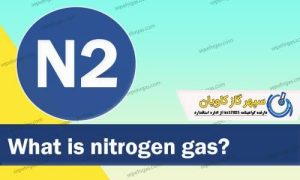?What is nitrogen gas
Nitrogen gas is the most abundant element in Earth’s atmosphere, making up about 78% of the air we breathe. It is a colorless, odorless, and tasteless gas that is essential for life, although we cannot breathe N2 directly.
This gas is nonreactive, meaning it doesn’t readily form bonds with other elements. Sepehr Gas Kavian has an ISO17025 certificate and is a reference laboratory of the Iranian Standards Authority. To buy pure and mixed gases, call 02146835980
Type: mix gas

Uses of nitrogen gas
Nitrogen gas’s biggest advantage is its inertness, meaning it doesn’t react with many things. This makes it a highly useful gas for various applications across industries. Here are some common uses of this gas:
Food Industry: This gas is used to create an oxygen-free environment around food products. This prevents oxidation, which can cause spoilage and loss of flavor. It’s used in packaging, storage, and even transporting perishable items like fruits and vegetables.
Preserving Products: This gas is used to create an inert atmosphere for various products like electronics, pharmaceuticals, and chemicals. This prevents them from degrading due to oxidation or exposure to air and moisture.
Fire Prevention: Because it displaces oxygen, N2 can be used in fire suppression systems. It removes the element that fuels combustion, effectively stopping fires.
Metal Manufacturing: N2 is used during the manufacturing of stainless steel and other metals. It prevents unwanted reactions and helps maintain the quality of the final product.
Tires and Aircraft: Dry nitrogen is used to inflate aircraft tires and race car tires. It maintains consistent pressure fluctuations over a wider temperature range compared to regular air, which can improve handling and safety.
Pharmaceuticals: N2 plays a role in various aspects of the pharmaceutical industry. Liquid nitrogen is used for freezing and preserving biological samples. In some cases, N2 itself is used in the manufacturing process of certain medications. Nitrous oxide, a form of N2, is also used as an anesthetic.
Dangers
N2 itself isn’t inherently poisonous, but it can be dangerous because it displaces oxygen. Here’s how:
Asphyxiation: Nitrogen makes up about 78% of the air we breathe, but the other 22% is crucial oxygen. Inhaling concentrated N2 pushes out the oxygen your body needs. This can lead to rapid suffocation, dizziness, unconsciousness, and even death if not addressed quickly.
Lack of Warning Signs: Unlike some harmful gases, this gas is odorless and colorless. You might not realize you’re in an oxygen-deficient environment until it’s too late.
Liquefied Nitrogen Burns: While N2 itself is not flammable, liquefied nitrogen (extremely cold liquid nitrogen) can cause severe frostbite on contact with skin or eyes.
Here are some situations where this gas poses a danger:
Confined Spaces: Working in enclosed areas with N2, like silos or tanks, can be hazardous without proper ventilation and safety measures.
Improper Handling: Leaks from nitrogen gas containers or industrial equipment can displace oxygen in a surrounding area.
Lab Accidents: N2 is commonly used in labs. Accidental spills or leaks of liquefied nitrogen can cause cold burns.
If you suspect N2 exposure, the most important thing is to get fresh air immediately. Move the person to a well-ventilated area and call emergency services.
By understanding the dangers and taking proper precautions, working with nitrogen gas can be done safely.
Sources
There are two main ways to obtain this gas: from the atmosphere and through specific industrial processes.
Air Separation (Most Common):
The Atmosphere: The biggest source of nitrogen gas is Earth’s atmosphere, where it makes up about 78% of the air.
Air Separation Techniques: Industrial facilities use special techniques, like pressure swing adsorption (PSA), to separate nitrogen from other gases in the air. PSA works by using pressurized air and specialized materials to selectively adsorb (cling to) oxygen molecules, allowing pure nitrogen gas to be collected.
Less Common Industrial Processes:
Chemical Reactions: In some cases, nitrogen gas can be a byproduct of specific chemical reactions. For instance, heating ammonium nitrite solutions or oxidizing ammonia with chemicals like bromine water can yield this gas. However, these methods are less common for large-scale production compared to air separation.
Preparation
To buy pure gases such as Argon, oxygen, hydrogen and helium, contact Sepehr Gas Kavian.
02146835980
02146837072


